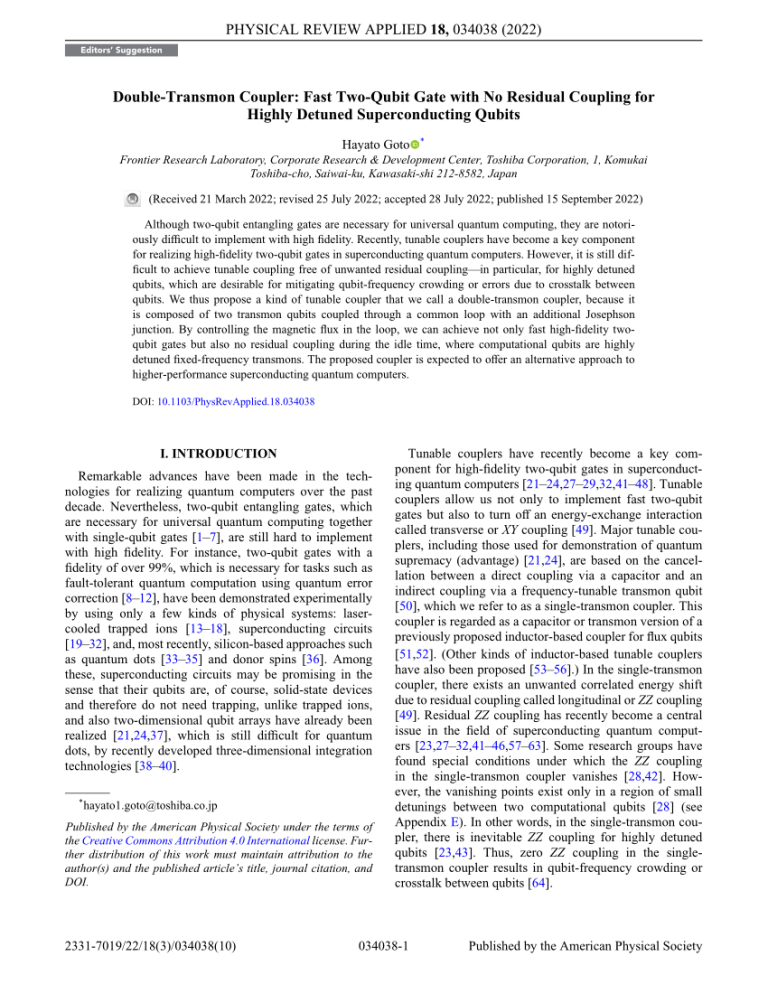
Toshiba researchers have achieved a breakthrough in quantum computing architecture by developing a basic dual transmon connector design that will improve the speed and accuracy of quantum computers compared to custom connectors. The coupler is a key element that determines the performance of superconducting quantum computers.
Tunable connectors in a superconducting quantum computer connect two quantum bits and perform quantum calculations by turning the connection between them on and off. Current technology can disable narrow frequency transmon qubit coupling, but this is subject to crosstalk errors that occur in one of the qubits when the other qubit is irradiated with electromagnetic waves for control. In addition, current technologies cannot completely disable the coupling of qubits with significantly different frequencies, which leads to errors due to residual coupling.
Recently, Toshiba has developed a dual transmon coupler that can completely turn on and off communication between qubits with completely different frequencies. Full-on enables high-speed, tightly coupled quantum computing, while full-off eliminates residual coupling, improving the speed and accuracy of quantum computing. Simulations using the new technology have shown that it performs two-qubit gates, the core operations of quantum computing, with 99.99% accuracy and a processing time of just 24 ns.
Toshiba's dual coupler can be applied to fixed-frequency transmon qubits to ensure high stability and ease of design. It is the first device to achieve communication between fixed-frequency transmon qubits with completely different frequencies that can be completely turned on and off, and offers an accurate high-speed two-qubit gate.
This technology is expected to spur the creation of more powerful quantum computers that will help in areas such as achieving carbon neutrality and developing new drugs. Details of the technology are published in the journal Physical Review Applied.
development fund
Quantum mechanics describes the invisible world of atoms and molecules in terms of states of quantum superposition, which allow a physical system to be in two completely different states at the same time. Quantum computers use this mysterious property to perform calculations that are nearly impossible with conventional computers, and this capability has received a lot of attention in recent years.
Quantum computers use qubits in quantum superposition states 0 and 1 to perform calculations. All quantum computing is done using two basic operations: single-qubit gates and two-qubit gates. To implement high-performance quantum computers, we need fast and accurate gate operations.
The development of quantum computers is being encouraged around the world, which has led to the adoption of several approaches, with proposals ranging from the manipulation of individual atoms or ions to the use of semiconductors and circuits in superconductors. The superconducting circuit approach is currently considered to be advantageous in terms of realizing quantum superposition states in large circuits and relatively easy to achieve the strong coupling of qubits, which is necessary for high-speed implementation of two-valve gates.
The connection of qubits is carried out using a connector. Until recently, thrust bearings were fixed clutches with a constant clutch force, but now attention is turning to adjustable clutches, which are considered to have the adjustable clutch force needed to improve performance.
Tunable couplers meet conflicting requirements: a fast, tightly coupled two-qubit gate, and the ability to reduce residual coupling errors by disabling coupling. It is also preferable that the qubit used in the calculations is a fixed frequency transmon qubit, which is very stable, has a simple structure, and is easy to fabricate.
In addition, the frequencies of the two coupled qubits should be significantly different, since this reduces crosstalk errors and prevents deviations from the calculated qubit frequencies, increasing the productivity of device fabrication. The problem here, however, is that no custom connector has yet been able to combine full decoupling and fast two-qubit gating operations for two fixed-frequency transmonqubits with significantly different frequencies.
Features of the new technology.
Toshiba researchers have developed a dual transmon coupler, the world's first tunable coupler capable of completely disconnecting both links and driving both high-speed qubit gates for two fixed-frequency transmon qubits at completely different frequencies.
The double thunk consists of two fixed-frequency transmon qubits along with two other fixed-frequency transmon qubits used for the calculation. A double transmon tap has one loop, and the three crosses in the loop represent two Josephson transmon connections and one additional Josephson connection. The magnetic flux in the Φex loop can be adjusted using an external magnetic field to bring the coupling strength between the qubits on both sides to exactly zero and completely disable the coupling.
The coupling strength can also be increased to tens of megahertz by increasing the magnetic flux, allowing fast operations on two qubits. Simulations have shown that triggering is possible with 99.99% accuracy with a trigger time of just 24 ns. Therefore, the coupler should contribute to the creation of more efficient quantum computers.
Further information: Hayato Goto, Double Transducer: A Fast Two-Qubit Gate without Residual Coupling for Highly Detuned Superconducting Qubits, Applied Physics Review (2022). DOI: 10.1103/PhysRevApplied.18.034038
Provided by Toshiba Corporation.
Citation: Double transmon coupler will make superconducting quantum computers faster and more accurate (2022-09-15) -superconductor.html
This document is protected by copyright. Except for fair use for private study or research purposes, no part may be reproduced without written permission. Content is provided for informational purposes only.

